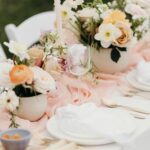Planning a wedding involves countless decisions, and one of the most important choices is selecting the perfect colors for the big day. From the invitations to the bridesmaid dresses and floral arrangements, wedding colors play a crucial role in setting the tone and creating a cohesive aesthetic. In this article, we will explore how to pick wedding colors that truly reflect the couple’s style and vision, taking into account the season, venue, trends, and even color psychology.
When it comes to choosing wedding colors, there are a multitude of factors to consider. The time of year plays a significant role in determining which colors will work best for a wedding. The bride’s personal vision for her dream wedding is also a key factor; after all, it is her special day. Furthermore, understanding popular color palettes and themes can provide inspiration and guidance for selecting colors that are both timeless and on-trend.
In addition to aesthetic considerations, there is also an emotional impact associated with different colors. By delving into color psychology, couples can gain insight into how certain colors can evoke specific feelings and create a certain atmosphere at their wedding. With so much to think about when it comes to picking wedding colors, it’s important to approach the decision-making process with careful consideration and attention to detail.
Considering the Season
When choosing wedding colors, one important factor to consider is the season in which the wedding will take place. The time of year can greatly influence the overall atmosphere and mood of the event, making it essential to select colors that complement the beauty of each season. Here are some tips on how to choose colors based on the time of year:
1. Spring: For weddings taking place in spring, soft pastel shades like pale pink, light peach, and mint green are popular choices. These colors reflect the blooming flowers and fresh foliage of the season, creating a romantic and whimsical ambiance.
2. Summer: Vibrant and bold hues are perfect for summer weddings, such as bright coral, sunny yellow, or turquoise blue. These colors capture the lively energy of summertime and can add a cheerful and fun vibe to the celebration.
3. Fall: Rich and earthy tones are ideal for autumn weddings, such as deep burgundy, burnt orange, or mustard yellow. These colors complement the changing leaves and warm textures of fall, evoking a cozy and rustic feel.
4. Winter: Cool tones like icy blue, silver gray, and emerald green are popular choices for winter weddings. These colors reflect the serene atmosphere of winter while adding an elegant touch to the event.
By considering the season when choosing wedding colors, couples can create a cohesive and harmonious palette that enhances the beauty of their special day while also aligning with the natural surroundings.
The Bride’s Vision
Another helpful tip is to consider the bride’s personal style and personality when choosing wedding colors. For example, if she has a bold and vibrant personality, she may lean towards bright and energetic colors. On the other hand, if she has a more romantic and soft-spoken demeanor, she may prefer pastel or muted tones. Taking these factors into account can ensure that the chosen colors truly reflect the bride’s individuality.
Ultimately, the most important thing is that the bride feels happy and comfortable with the chosen wedding colors. After all, it is her special day, and her satisfaction should be a top priority when making these decisions.
| Key Tips | Explanation |
|---|---|
| Open communication | Talk to the bride about her vision for her dream wedding |
| Consider personality | Take into account the bride’s personal style and demeanor when selecting colors |
| Bride’s satisfaction | Ensure that the chosen colors make the bride feel happy and comfortable on her special day. |
Incorporating Trends
When it comes to choosing wedding colors, it’s important to consider the current trends and popular color palettes. This can be a great starting point for couples who are unsure of where to begin in selecting their wedding colors. Utilizing popular color palettes and themes can not only ensure that your wedding looks stylish and modern but can also make it easier to find decor and accessories in your chosen colors.
Researching Current Trends
Before settling on any specific wedding colors, it’s a good idea to do some research into current trends in the wedding industry. Look at recent weddings on social media platforms, bridal magazines, and wedding websites to get a sense of what colors and themes are currently popular. This will give you a good idea of what is currently “in” and may inspire you with some ideas for your own wedding color scheme.
Consulting With Experts
Wedding planners, florists, and other industry professionals can also provide valuable insight into current trends in wedding colors. These experts are well-versed in what is currently popular and can offer advice on how to incorporate trendy colors into your overall wedding vision. They can also help you avoid overdone or outdated color schemes, ensuring that your wedding looks fresh and modern.
Adding Personal Touches
While incorporating current trends into your wedding color palette can be helpful, it’s also important to remember that the most important thing is that the colors reflect the couple’s personalities and tastes. Even when utilizing popular color palettes and themes, don’t be afraid to add personal touches that reflect your unique style as a couple. Remember that this is ultimately about creating an event that feels authentic and special to you both.
Venue and Decor
After considering the season and the bride’s vision, the next step in choosing the perfect wedding colors is to take into account the venue and decor. The colors you choose should complement and enhance the space where you will be tying the knot, as well as the overall aesthetic you want to achieve. Here are some tips on how to match your wedding colors to your venue and decor:
- Consider the color scheme of your venue: Take a look at the walls, carpeting, and any permanent fixtures in your chosen venue. If it has a specific color palette, it’s important to choose wedding colors that will work well with these existing tones.
- Think about the style of your decor: Whether you’re going for a romantic, rustic, modern, or vintage vibe, your decor choices will influence the color scheme of your wedding. For instance, if you’re incorporating a lot of greenery and natural elements into your decor, earthy tones may work best.
- Use accent colors to add depth: If your venue has neutral or muted tones, consider using accent colors to make your wedding colors pop. Adding pops of bold or bright colors through flowers, linens, or other decorative elements can create visual interest.
Keep in mind that while it’s important for your wedding colors to harmonize with your venue and decor, they should also reflect your personal style and preferences as a couple. By carefully coordinating these elements, you can create a cohesive look that brings together all aspects of your special day.
Incorporating the venue’s color scheme and paying attention to decor style ensure that everything fits perfectly together on this significant day. Be sure that every aspect compliments one another by taking into consideration each element separately before solidifying a final decision regarding wedding colors.
Mixing and Matching
Choosing wedding colors can be a daunting task, especially when considering the multitude of options available. One effective way to create a cohesive color scheme for your wedding is by mixing and matching multiple shades. This approach allows for creativity and flexibility while ensuring that the overall look is visually appealing.
When mixing and matching colors for your wedding, it’s essential to consider shades that complement each other. Selecting a primary color as the foundation for your palette and then incorporating complementary or contrasting shades can add depth and visual interest to your overall aesthetic. For example, if you choose a soft pastel pink as your main color, you could incorporate shades of ivory, sage green, or gold to create a harmonious blend.
Furthermore, incorporating different textures and patterns can enhance the overall look of your color scheme. Consider incorporating metallic accents, such as gold or rose gold, to add a touch of elegance to your chosen color palette. Additionally, mixing solid colors with delicate floral prints or geometric patterns can add visual intrigue while maintaining cohesion within your overall wedding theme.
Incorporating multiple shades into your wedding color scheme allows for versatility in design elements such as bridesmaid dresses, floral arrangements, table linens, and stationery. By carefully selecting and combining various hues, you can create an aesthetically pleasing and harmonious ambiance for your special day.
| Creating a Cohesive Color Scheme | Mixing Multiple Shades |
|---|---|
| Consider complementary or contrasting shades | Selecting primary color foundation |
| Incorporate textures such as metallic accents | Mix solid colors with prints or patterns |
| Versatility in design elements like bridesmaid dresses | Careful selection of various hues |
Color Psychology
Color plays a significant role in evoking emotions and creating ambiance, making it crucial to understand the emotional impact of different colors when choosing wedding colors. Each color carries its own psychological significance, which can influence the mood and atmosphere of the wedding. Understanding these associations can help couples make informed decisions about the colors they choose for their special day.
For example, red is often associated with passion, love, and energy, making it a popular choice for romantic weddings. On the other hand, blue is linked to serenity, tranquility, and trust, making it ideal for creating a calming and peaceful atmosphere. By considering the emotional impact of colors, couples can align their color choices with the desired feeling they want to evoke on their wedding day.
It’s also essential to recognize that individual experiences and cultural differences can influence how people perceive certain colors. While white symbolizes purity and innocence in Western cultures, it may represent mourning in some Eastern cultures.
Therefore, couples should take into account their own cultural backgrounds and personal associations when selecting wedding colors. By understanding color psychology and considering these factors, couples can ensure that their chosen colors resonate with them personally while also creating the desired emotional atmosphere for their wedding.
In addition to personal preferences and cultural influences, it’s important to consider the preferences of guests as well. Different colors may trigger varying emotional responses among guests, so couples might also take this into account when finalizing their wedding color scheme. Overall, understanding color psychology is an invaluable tool for couples seeking to create a meaningful and emotionally resonant atmosphere on their special day.
Finalizing the Decision
Seek Input From Key Stakeholders
When it comes to finalizing the decision on wedding colors, it’s important to seek input from key stakeholders. This may include the bride and groom, of course, but also parents or close family members who may have strong opinions. Taking into account the preferences and visions of those closest to the wedding can help ensure that the chosen colors are meaningful and representative of everyone involved.
Consider Color Coordination With Bridal Party Attire
Another crucial factor in finalizing the decision on wedding colors is considering how they will coordinate with the attire of the bridal party. Bridesmaids’ dresses, groomsmen’s suits, and other attire should complement and enhance the chosen color scheme. It’s essential to envision how these colors will work together in photographs and throughout the ceremony and reception.
Create a Mock-Up or Mood Board
One highly effective way to solidify a decision on wedding colors is to create a mock-up or mood board. This could involve gathering swatches of fabric, paint chips, or images that reflect the desired color palette. Seeing these elements together can help bring the vision to life and make it easier to assess whether certain colors work well together. Furthermore, having a physical representation can also aid in decision-making when it comes to choosing flowers, decor, and stationery.
By incorporating these tips into your decision-making process for choosing wedding colors, you can ensure that you select a palette that represents your vision while also aligning with practical considerations such as season, venue, decor, and personal preferences.
Conclusion
When it comes to picking the perfect wedding colors, there are several key steps to consider. Understanding the significance of wedding colors and how they can impact the overall feel of the event is crucial. From considering the season and the bride’s vision to incorporating trends and venue decor, there are many factors to take into account when making this important decision.
It’s important to remember that this decision should ultimately reflect the couple’s unique style and personality. While it’s great to consider trends and popular color palettes, it’s also essential to stay true to what feels right for you as a couple. Whether you choose bold and vibrant colors or opt for softer, more romantic tones, make sure that your selections resonate with both of you.
In conclusion, picking the perfect wedding colors requires thoughtful consideration and a good understanding of how different elements come together. By following these steps outlined in this article, couples can ensure they select the ideal colors for their special day that not only reflect their vision but also create a beautiful and cohesive atmosphere for all in attendance. No matter which colors you choose, remember that it’s all about creating a day that feels uniquely yours.
Frequently Asked Questions
How Do I Choose a Color Scheme for My Wedding?
When choosing a color scheme for your wedding, consider the season, your personal style, and the overall atmosphere you want to create. Take into account the venue and any specific themes or cultural elements you want to incorporate.
How Do I Choose the Color of the Day for My Wedding?
The color of the day for your wedding should reflect your personality as a couple and tie in with the overall theme or mood of the event. Consider colors that make you both feel happy and comfortable, as well as ones that complement each other.
How Many Colors Should You Have for a Wedding?
There is no set rule on how many colors you should have for a wedding, but it’s generally best to stick to 2-4 main colors. Too many colors can be overwhelming and may not create a cohesive look. Use accents in additional colors to add pops of interest without overwhelming the palette.

Welcome to my blog about home and family. This blog is a place where I will share my thoughts, ideas, and experiences related to these important topics. I am a stay-at-home mom with two young children. I hope you enjoy reading it! and may find some helpful tips and ideas that will make your home and family life even better!





